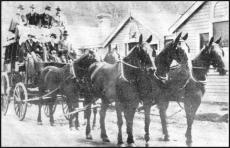Ride quality…
 I have never been for a ride in a stage coach but it’s something I’d very much like to do. And preferably at full speed, the team of horses at a gallop. Why? Well, primarily because I wonder how well the coaches ride.
I have never been for a ride in a stage coach but it’s something I’d very much like to do. And preferably at full speed, the team of horses at a gallop. Why? Well, primarily because I wonder how well the coaches ride.
I have a book on Cobb & Co, the best known and largest of the stagecoach companies in Australia’s history, and the map showing the routes that the coaches took is stunning. Especially in Queensland, they penetrated way into the inland – true Outback territory. The roads – always dirt and often largely unmade – were terrible and yet the point to point times were actually quite quick. (The coaches ran to timetables like buses do today.)
The coaches used long-travel (and large!) elliptical leaf springs – sometimes transverse as well as longitudinal – and had huge wheels. AFAIK, damping was provided only by the inter-leaf friction of the springs – no dampers were fitted. In short, the suspension design was as far away from contemporary small wheel, short travel, highly damped suspensions as possible.
But I have a suspicion that these vehicles might have had a very good ride indeed. The large wheels simply wouldn’t have noticed the bumps that a modern car’s wheel would crash into; the very long suspension travel and low natural frequency (at a guess the static deflection would give a resonant frequency near to 1Hz) is close to ideal for human comfort.
A horse-drawn stage coach riding better than a current car? I wonder…

 Julian Edgar, 50, has been writing about car modification and automotive technology for nearly 25 years. He has owned cars with two, three, four, five, six and eight cylinders; single turbo, twin turbo, supercharged, diesel and hybrid electric drivelines. He lists his transport interests as turbocharging, aerodynamics, suspension design and human-powered vehicles.
Julian Edgar, 50, has been writing about car modification and automotive technology for nearly 25 years. He has owned cars with two, three, four, five, six and eight cylinders; single turbo, twin turbo, supercharged, diesel and hybrid electric drivelines. He lists his transport interests as turbocharging, aerodynamics, suspension design and human-powered vehicles.

on October 23rd, 2007 at 8:57 am
Was it Cobb & Co that had the largest stagecoach in Australia? I remember seeing it on American Chopper when Russell Crowe was taking the guys around for a tour – somewhere in northern NSW. The leaf springs on that were massive.
on October 23rd, 2007 at 9:54 am
You need C5 Citroen!
[But you burnt your bridges with ATECO, and rigthly so!!] 🙂
Cheers
O/A
on October 23rd, 2007 at 8:09 pm
By the sounds of it, you would still feel every bump, but it would be more like a vibration. Similar to the old friction shocks.
I wonder if anyone building a stagecoach from scratch today (only to look externally similar to the old examples) would put in a coil spring and hydraulic shock setup? Or would airbags be the go?
on October 24th, 2007 at 7:34 am
For a very long time I’ve wondered why we use such small wheels when larger wheels are so much better over bumpy roads.
Maybe this trend in increasing wheel sizes is actually heading in the right direction for comfort…
on October 24th, 2007 at 7:44 am
The equivalent nowadays would be something like a current Range Rover. Large mass, long travel suspension, tyres with large rolling circumference
on October 24th, 2007 at 10:49 pm
the ride might be better (though I doubt that would be the case at anything other than moderate speed, and even then, possibly not), but trying to make it change direction, especially at the speeds modern cars are capable of? I’ll stick with 100 years of advancement thanks.
on November 17th, 2007 at 8:33 am
Bigger wheels don’t notice bumps as much and aren’t “bullied around” by bumps as much from higher mass, but more unsprung weight is a bad thing when it comes to suspension design and that’s the issue with the newer larger, heavier wheels and tires. Plus, they tend to be wider so they have more rolling resistance, (although handling generally improves).
Atul
http://www.realitydriven.com
on May 21st, 2009 at 4:39 am
I imagine the filling in my shaking loose on a stage coach ride!